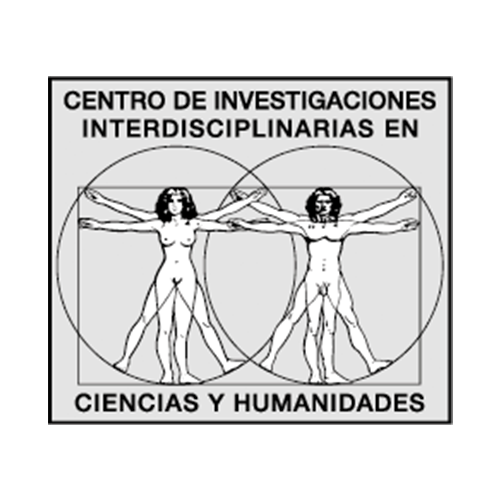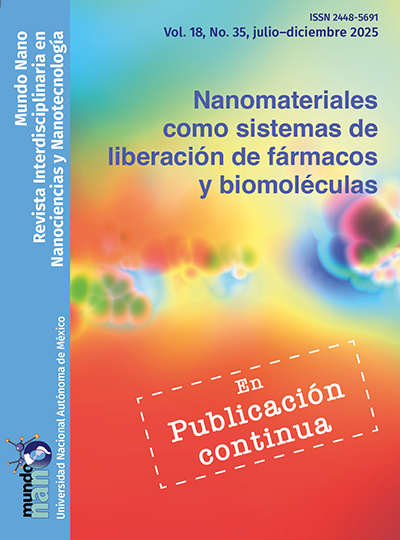Nanopartículas viromiméticas para la entrega de ácidos nucleicos en el estudio del parásito Trypanosoma cruzi
Contenido principal del artículo
Resumen
La enfermedad de Chagas, causada por el parásito Trypanosoma cruzi, sigue siendo una patología desatendida con altas tasas de subdiagnóstico y opciones terapéuticas limitadas, especialmente en la fase crónica. A pesar de los avances en biología molecular, el estudio funcional de genes en T. cruzi enfrenta grandes desafíos debido a su diversidad genética y a la falta de herramientas eficientes para la entrega de ácidos nucleicos. En este contexto, las nanopartículas viromiméticas (NPVM) se perfilan como plataformas bioinspiradas, las cuales imitan propiedades estructurales y funcionales de los virus, permitiendo una entrega segura, dirigida y poco inmunogénica de material genético. Se abordan los principios de diseño, características funcionales y aplicaciones biomédicas de las NPVM. Se destaca el caso del sistema viromimético C4BK12 como ejemplo de entrega de oligonucleótidos antisentido en T. cruzi, evidenciado el potencial de estas plataformas como herramientas emergentes para la investigación funcional y el desarrollo de nuevas estrategias terapéuticas dirigidas.
Descargas
Detalles del artículo

Mundo Nano. Revista Interdisciplinaria en Nanociencias y Nanotecnología, editada por la Universidad Nacional Autónoma de México, se distribuye bajo una Licencia Creative Commons Atribución-NoComercial 4.0 Internacional.
Basada en una obra en http://www.mundonano.unam.mx.
Citas
Alonso-Valenteen, F., S. Pacheco, D. Srinivas, A. Rentsendorj, D. Chu, J. Lubow, J. Sims, T. Miao, S. Mikhael, J. Y. Hwang, R. Abrol y L. K. Medina Kauwe. (2019). HER3-targeted protein chimera forms endosomolytic capsomeres and self-assembles into stealth nucleocapsids for systemic tumor homing of RNA interference in vivo. Nucleic Acids Res, 47(21): 11020-11043. https://doi.org/10.1093/nar/gkz900. DOI: https://doi.org/10.1093/nar/gkz900
Araya, J. E., A. Cornejo, P. R. Orrego, E. M. Cordero, M. Cortéz, H. Olivares, I. Neira, H. Sagua, J. F. da Silveira, N. Yoshida y J. González. (2008). Calcineurin B of the human protozoan parasite Trypanosoma cruzi is involved in cell invasion. Microbes Infect, 10(8): 892-900. https://doi.org/10.1016/j.micinf.2008.05.003. DOI: https://doi.org/10.1016/j.micinf.2008.05.003
Arias, J. L., J. D. Unciti-Broceta, J. Maceira, T. del Castillo, J. Hernández-Quero, S. Magez, M. Soriano y J. A. García-Salcedo. (2015). Nanobody conjugated PLGA nanoparticles for active targeting of African trypanosomiasis. J Control Release, 197: 190-8. https://doi.org/10.1016/j.jconrel.2014.11.002. DOI: https://doi.org/10.1016/j.jconrel.2014.11.002
Arroyo-Olarte, Rubén D., Ignacio Martínez, Eduardo Luján, Fela Mendlovic, Tzvetanka Dinkova y Bertha Espinoza. (2020). Differential gene expression of virulence factors modulates infectivity of TcI Trypanosoma cruzi strains. Parasitology Research, 119(11): 3803-3815. https://doi.org/10.1007/s00436-020-06891-1. DOI: https://doi.org/10.1007/s00436-020-06891-1
Bale, Jacob B., Shane Gonen, Yuxi Liu, William Sheffler, Daniel Ellis, Chantz Thomas, Duilio Cascio, Todd O. Yeates, Tamir Gonen, Neil P. King y David Baker. (2016). Accurate design of megadalton-scale two-component icosahedral protein complexes. Science, 353(6297): 389-394. https://doi.org/doi:10.1126/science.aaf8818. DOI: https://doi.org/10.1126/science.aaf8818
Bhattacharyya, T., N. Murphy y M. A. Miles. (2024). Diversity of Chagas disease diagnostic antigens: successes and limitations. PLoS Negl Trop Dis, 18(10): e0012512. https://doi.org/10.1371/journal.pntd.0012512. DOI: https://doi.org/10.1371/journal.pntd.0012512
Butterfield, G. L., M. J. Lajoie, H. H. Gustafson, D. L. Sellers, U. Nattermann, D. Ellis, J. B. Bale, S. Ke, G. H. Lenz, A. Yehdego, R. Ravichandran, S. H. Pun, N. P. King y D. Baker. (2017). Evolution of a designed protein assembly encapsulating its own RNA genome. Nature, 552(7685): 415-420. https://doi.org/10.1038/nature25157. DOI: https://doi.org/10.1038/nature25157
Cárdenas-Guerra, R. E., Martínez, I. y Espinoza, B. (2022). Papel de la enzima nitroreductasa tipo I de Trypanosoma cruzi en el metabolismo de fármacos anti-chagásicos. Revista Mexicana de Industria y Salud, 2(15): 36-42. ISSN: 2594-1445.
Cárdenas-Guerra, R. E., D. S. Moreno-Gutiérrez, O. J. Vargas-Dorantes, B. Espinoza y A. Hernández-García. (2020). Delivery of antisense DNA into pathogenic parasite Trypanosoma cruzi using virus-like protein-based nanoparticles. Nucleic Acid Ther, 30(6): 392-401. https://doi.org/10.1089/nat.2020.0870. DOI: https://doi.org/10.1089/nat.2020.0870
CDC -DPDx- American Trypanosomiasis. https://www.cdc.gov/dpdx/trypanosomiasisamerican/index.html.
DaRocha, W. D., K. Otsu, S. M. Teixeira y J. E. Donelson. (2004). Tests of cytoplasmic RNA interference (RNAi) and construction of a tetracycline-inducible T7 promoter system in Trypanosoma cruzi. Mol Biochem Parasitol, 133(2): 175-86. https://doi.org/10.1016/j.molbiopara.2003.10.005. DOI: https://doi.org/10.1016/j.molbiopara.2003.10.005
De Freitas Oliveira, J. W., M. F. A. da Silva, I. Z. Damasceno, H. A. O. Rocha, A. A. da Silva Júnior y M. S. Silva. (2022). In vitro validation of antiparasitic activity of PLA-nanoparticles of sodium diethyldithiocarbamate against Trypanosoma cruzi. Pharmaceutics, 14(3). https://doi.org/10.3390/pharmaceutics14030497. DOI: https://doi.org/10.3390/pharmaceutics14030497
De Sousa, A. S., D. Vermeij, A. N. Ramos, Jr. y A. O. Luquetti. (2024). Chagas disease. Lancet, 403(10422): 203-218. https://doi.org/10.1016/s0140-6736(23)01787-7. DOI: https://doi.org/10.1016/S0140-6736(23)01787-7
Dirección General de Epidemiología. (2022). Tripanosomiasis. SUIVE/DGE / Secretaría de Salud / Estados Unidos Mexicanos 2022. https://epidemiologia.salud.gob.mx/anuario/html/incidencia_enfermedad.html.
DNDi. (2024). Symptoms, transmission, and current treatments for Chagas disease |DNDi https://dndi.org/diseases/chagas/facts/.
Dumonteil, E., H. Desale, W. Tu, N. Hernández-Cuevas, M. Shroyer, K. Goff, P. A. Marx y C. Herrera. (2023). Intra-host Trypanosoma cruzi strain dynamics shape disease progression: the missing link in Chagas disease pathogenesis. Microbiol Spectr, 11(5): e0423622. https://doi.org/10.1128/spectrum.04236-22. DOI: https://doi.org/10.1128/spectrum.04236-22
Edwardson, T. G. W. y D. Hilvert. (2019). Virus-inspired function in engineered protein cages. J Am Chem Soc, 141(24): 9432-9443. https://doi.org/10.1021/jacs.9b03705. DOI: https://doi.org/10.1021/jacs.9b03705
Francisco, A. F., S. Jayawardhana, F. Olmo, M. D. Lewis, S. R. Wilkinson, M. C. Taylor y J. M. Kelly. (2020). Challenges in Chagas disease drug development. Molecules, 25(12). https://doi.org/10.3390/molecules25122799. DOI: https://doi.org/10.3390/molecules25122799
Gabaldón-Figueira, J. C., N. Martínez-Peinado, E. Escabia, A. Ros-Lucas, E. Chatelain, I. Scandale, J. Gascon, M. J. Pinazo y J. Alonso-Padilla. (2023). State-of-the-art in the drug discovery pathway for Chagas disease: a framework for drug development and target validation. Res Rep Trop Med, 14: 1-19. https://doi.org/10.2147/rrtm.S415273. DOI: https://doi.org/10.2147/RRTM.S415273
Gao, X., J. Ding, Q. Long y C. Zhan. (2021). Virus-mimetic systems for cancer diagnosis and therapy. Wiley Interdiscip Rev Nanomed Nanobiotechnol, 13(3): e1692. https://doi.org/10.1002/wnan.1692. DOI: https://doi.org/10.1002/wnan.1692
Gupta, A., J. L. Andresen, R. S. Manan y R. Langer. (2021). Nucleic acid delivery for therapeutic applications. Adv Drug Deliv Rev, 178: 113834. https://doi.org/10.1016/j.addr.2021.113834. DOI: https://doi.org/10.1016/j.addr.2021.113834
Hashimoto, M., M. Doi, N. Kurebayashi, K. Furukawa, H. Hirawake-Mogi, Y. Ohmiya, T. Sakurai, T. Mita, K. Mikoshiba y T. Nara. (2016). Inositol 1,4,5-trisphosphate receptor determines intracellular Ca(2+) concentration in Trypanosoma cruzi throughout its life cycle. FEBS Open Bio, 6(12): 1178-1185. https://doi.org/10.1002/2211-5463.12126. DOI: https://doi.org/10.1002/2211-5463.12126
Hashimoto, M., T. Nara, H. Hirawake, J. Morales, M. Enomoto y K. Mikoshiba. (2014). Antisense oligonucleotides targeting parasite inositol 1,4,5-trisphosphate receptor inhibits mammalian host cell invasion by Trypanosoma cruzi. Sci Rep, 4: 4231. https://doi.org/10.1038/srep04231. DOI: https://doi.org/10.1038/srep04231
Hernández-García, A., D. J. Kraft, A. F. Janssen, P. H. Bomans, N. A. Sommerdijk, D. M. Thies-Weesie, M. E. Favretto, R. Brock, F. A. de Wolf, M. W. Werten, P. van der Schoot, M. C. Stuart y R. de Vries. (2014). Design and self-assembly of simple coat proteins for artificial viruses. Nat Nanotechnol, 9(9): 698-702. https://doi.org/10.1038/nnano.2014.169. DOI: https://doi.org/10.1038/nnano.2014.169
Hernández-García, A., M. W. Werten, M. C. Stuart, F. A. de Wolf y R. de Vries. (2012). Coating of single DNA molecules by genetically engineered protein diblock copolymers. Small, 8(22): 3491-501. https://doi.org/10.1002/smll.201200939. DOI: https://doi.org/10.1002/smll.201200939
Kanekiyo, M., C. J. Wei, H. M. Yassine, P. M. McTamney, J. C. Boyington, J. R. Whittle, S. S. Rao, W. P. Kong, L. Wang y G. J. Nabel. (2013). Self-assembling influenza nanoparticle vaccines elicit broadly neutralizing H1N1 antibodies. Nature, 499(7456): 102-6. https://doi.org/10.1038/nature12202. DOI: https://doi.org/10.1038/nature12202
Kole, R., A. R. Krainer y S. Altman. (2012). RNA therapeutics: beyond RNA interference and antisense oligonucleotides. Nat Rev Drug Discov, 11(2): 125-40. https://doi.org/10.1038/nrd3625. DOI: https://doi.org/10.1038/nrd3625
Li, Yang, Jinyan Lin, Peiyuan Wang, Qiang Luo, Huirong Lin, Yun Zhang, Zhenqing Hou, Jingfeng Liu y Xiaolong Liu. (2019). Tumor microenvironment responsive shape-reversal self-targeting virus-inspired nanodrug for imaging-guided near-infrared-II photothermal chemotherapy. ACS Nano, 13(11): 12912-12928. https://doi.org/10.1021/acsnano.9b05425. DOI: https://doi.org/10.1021/acsnano.9b05425
Málaga, S. y N. Yoshida. (2001). Targeted reduction in expression of Trypanosoma cruzi surface glycoprotein gp90 increases parasite infectivity. Infect Immun, 69(1): 353-9. https://doi.org/10.1128/iai.69.1.353-359.2001. DOI: https://doi.org/10.1128/IAI.69.1.353-359.2001
Matsuura, Kazunori, Kenta Watanabe, Tsubasa Matsuzaki, Kazuo Sakurai y Nobuo Kimizuka. (2010). Self-assembled synthetic viral capsids from a 24-mer viral peptide fragment. Angew Chem Int Ed, 49(50): 9662-9665. https://doi.org/10.1002/anie.201004606. DOI: https://doi.org/10.1002/anie.201004606
Mengarda, A. C., B. Iles, J. P. F. Longo y J. de Moraes. (2023). Recent approaches in nanocarrier-based therapies for neglected tropical diseases. Wiley Interdiscip Rev Nanomed Nanobiotechnol, 15(2): e1852. https://doi.org/10.1002/wnan.1852. DOI: https://doi.org/10.1002/wnan.1852
Modrow, S., D. Falke, U. Truyen y H. Schätzl. (2013). Viruses: definition, structure, classification. En Molecular virology, 17-30. https:/doi.org/10.1007/978-3-642-20718-1_2. DOI: https://doi.org/10.1007/978-3-642-20718-1_2
Moreno-Gutiérrez, D. S., X. Del Toro-Ríos, N. J. Martínez-Sulvaran, M. B. Pérez-Altamirano y A. Hernéndez-García. (2023). Programming the cellular uptake of protein-based viromimetic nanoparticles for enhanced delivery. Biomacro- molecules, 24(4): 1563-1573. https://doi.org/10.1021/acs.biomac.2c01295. DOI: https://doi.org/10.1021/acs.biomac.2c01295
Moreno-Gutiérrez, D. S., J. Zepeda-Cervantes, L. Vaca y A. Hernéndez-García. (2021). An artificial virus-like triblock protein shows low in vivo humoral immune response and high stability. Mater Sci Eng C Mater Biol Appl, 129: 112348. https://doi.org/10.1016/j.msec.2021.112348. DOI: https://doi.org/10.1016/j.msec.2021.112348
Muraca, G., M. E. Ruiz, R. C. Gambaro, S. Scioli-Montoto, M. L. Sbaraglini, G. Padula, J. S. Cisneros, C. Y. Chain, V. A. Álvarez, C. Huck-Iriart, G. R. Castro, M. B. Piñero, M. I. Marchetto, C. Alba Soto, G. A. Islan y A. Talevi. (2023). Nanostructured lipid carriers containing benznidazole: physicochemical, biopharmaceutical and cellular in vitro studies. Beilstein J Nanotechnol, 14: 804-818. https://doi.org/10.3762/bjnano.14.66. DOI: https://doi.org/10.3762/bjnano.14.66
Ni, R., J. Zhou, N. Hossain y Y. Chau. (2016). Virus-inspired nucleic acid delivery system: linking virus and viral mimicry. Adv Drug Deliv Rev, 106(Pt A): 3-26. https://doi.org/10.1016/j.addr.2016.07.005. DOI: https://doi.org/10.1016/j.addr.2016.07.005
Ni, Y., J. Wang, M. Wang, L. Liu, H. Nie, Q. Wang, J. Sun, T. Yue, M. Q. Zhu y J. Wang. (2022). COVID-19-inspired “artificial virus” to combat drug-resistant bacteria by membrane-intercalation- photothermal-photodynamic multistage effects. Chem Eng J, 446: 137322. https://doi.org/10.1016/j.cej.2022.137322. DOI: https://doi.org/10.1016/j.cej.2022.137322
Niu, Y., M. Yu, S. B. Hartono, J. Yang, H. Xu, H. Zhang, J. Zhang, J. Zou, A. Dexter, W. Gu y C. Yu. (2013). Nanoparticles mimicking viral surface topography for enhanced cellular delivery. Adv Mater, 25(43): 6233-7. https://doi.org/10.1002/adma.201302737. DOI: https://doi.org/10.1002/adma.201302737
Okura, M., J. Fang, M. L. Salto, R. S. Singer, R. Docampo y S. N. Moreno. (2005). A lipid-modified phosphoinositide-specific phospholipase C (TcPI-PLC) is involved in differentiation of trypomastigotes to amastigotes of Trypanosoma cruzi. J Biol Chem, 280(16): 16235-43. https://doi.org/10.1074/jbc.M414535200. DOI: https://doi.org/10.1074/jbc.M414535200
Olmo, F., F. C. Costa, G. S. Mann, M. C. Taylor y J. M. Kelly. (2018). Optimising genetic transformation of Trypanosoma cruzi using hydroxyurea-induced cell-cycle synchronisation. Mol Biochem Parasitol, 226: 34-36. https://doi.org/10.1016/j.molbiopara.2018.07.002. DOI: https://doi.org/10.1016/j.molbiopara.2018.07.002
OPS. (2024). Enfermedad de Chagas - OPS/OMS | Organización Panamericana de la Salud (paho.org). https://www.paho.org/es/temas/enfermedad-chagas.
Orrego, P. R., H. Olivares, E. M. Cordero, A. Bressan, M. Cortez, H. Sagua, I. Neira, J. González, J. F. da Silveira, N. Yoshida y J. E. Araya. (2014). A cytoplasmic new catalytic subunit of calcineurin in Trypanosoma cruzi and its molecular and functional characterization. PLoS Negl Trop Dis, 8(1): e2676. https://doi.org/10.1371/journal.pntd.0002676. DOI: https://doi.org/10.1371/journal.pntd.0002676
Padmanabhan, P. K., R. B. Polidoro, N. S. Barteneva, R. T. Gazzinelli y B. A. Burleigh. (2014). Transient transfection and expression of foreign and endogenous genes in the intracellular stages of Trypanosoma cruzi. Mol Biochem Parasitol, 198(2): 100-3. https://doi.org/10.1016/j.molbiopara.2015.02.001. DOI: https://doi.org/10.1016/j.molbiopara.2015.02.001
Pérez-Molina, J. A. e I. Molina. (2018). Chagas disease. Lancet, 391(10115): 82-94. https://doi.org/10.1016/s0140-6736(17)31612-4. DOI: https://doi.org/10.1016/S0140-6736(17)31612-4
Perrault, S. D. y W. M. Shih. (2014). Virus-inspired membrane encapsulation of DNA nanostructures to achieve in vivo stability. ACS Nano, 8(5): 5132-40. https://doi.org/10.1021/nn5011914. DOI: https://doi.org/10.1021/nn5011914
Punter, M. T., A. Hernández-García, D. J. Kraft, R. de Vries y P. van der Schoot. (2016). Self-assembly dynamics of linear virus-like particles: theory and experiment. J Phys Chem B, 120(26): 6286-97. https://doi.org/10.1021/acs.jpcb.6b02680. DOI: https://doi.org/10.1021/acs.jpcb.6b02680
Quijia Quezada, C., C. S. Azevedo, S. Charneau, J. M. Santana, M. Chorilli, M. B. Carneiro e I. M. D. Bastos. (2019). Advances in nanocarriers as drug delivery systems in Chagas disease. Int J Nanomedicine, 14: 6407-6424. https://doi.org/10.2147/ijn.S206109. DOI: https://doi.org/10.2147/IJN.S206109
Romero, E. L. y M. J. Morilla. (2010). Nanotechnological approaches against Chagas disease. Adv Drug Deliv Rev, 62(4-5): 576-88. https://doi.org/10.1016/j.addr.2009.11.025. DOI: https://doi.org/10.1016/j.addr.2009.11.025
San Francisco, Juan, Iván Barría, Bessy Gutiérrez, Iván Neira, Christian Muñoz, Hernán Sagua, Jorge E. Araya, Juan Carlos Andrade, Aníbal Zailberger, Alejandro Catalán, Francisco Remonsellez, José Luis Vega y Jorge González. (2017). Decreased cruzipain and gp85/trans-sialidase family protein expression contributes to loss of Trypanosoma cruzi trypomastigote virulence. Microbes Infect, 19(1): 55-61. https://doi.org/10.1016/j.micinf.2016.08.003. DOI: https://doi.org/10.1016/j.micinf.2016.08.003
Terasaka, N., Y. Azuma y D. Hilvert. (2018). Laboratory evolution of virus-like nucleocapsids from nonviral protein cages. Proc Natl Acad Sci USA, 115(21): 5432-5437. https://doi.org/10.1073/pnas.1800527115. DOI: https://doi.org/10.1073/pnas.1800527115
Walls, A. C., B. Fiala, A. Schäfer, S. Wrenn, M. N. Pham, M. Murphy, L. V. Tse, L. Shehata, M. A. O’Connor, C. Chen, M. J. Navarro, M. C. Miranda, D. Pettie, R. Ravichandran, J. C. Kraft, C. Ogohara, A. Palser, S. Chalk, E. C. Lee, K. Guerriero, E. Kepl, C. M. Chow, C. Sydeman, E. A. Hodge, B. Brown, J. T. Fuller, K. H. Dinnon, 3rd, L. E. Gralinski, S. R. Leist, K. L. Gully, T. B. Lewis, M. Guttman, H. Y. Chu, K. K. Lee, D. H. Fuller, R. S. Baric, P. Kellam, L. Carter, M. Pepper, T. P. Sheahan, D. Veesler y N. P. King. (2020). Elicitation of potent neutralizing antibody responses by designed protein nanoparticle vaccines for SARS-CoV-2. Cell, 183(5): 1367-1382.e17. https://doi.org/10.1016/j.cell.2020.10.043. DOI: https://doi.org/10.1016/j.cell.2020.10.043
WHO. (2024). Enfermedad de Chagas (tripanosomiasis americana). https://www.who.int/es/news-room/fact-sheets/detail/chagas-disease-(american-trypanosomiasis).
Yang, Y., Y. Hong, G. H. Nam, J. H. Chung, E. Koh e I. S. Kim. (2017). Virus-mimetic fusogenic exosomes for direct delivery of integral membrane proteins to target cell membranes. Adv Mater, 29(13). https://doi.org/10.1002/adma.201605604. DOI: https://doi.org/10.1002/adma.201605604
Zhang, P., Y. Chen, Y. Zeng, C. Shen, R. Li, Z. Guo, S. Li, Q. Zheng, C. Chu, Z. Wang, Z. Zheng, R. Tian, S. Ge, X. Zhang, N. S. Xia, G. Liu y X. Chen. (2015). Virus-mimetic nanovesicles as a versatile antigen-delivery system. Proc Natl Acad Sci USA, 112(45): E6129-38. https://doi.org/10.1073/pnas.1505799112. DOI: https://doi.org/10.1073/pnas.1505799112
Zhao, Xiu, Yiyang Wang, Wenxiao Jiang, Qiongwei Wang, Jun Li, Zhiyang Wen, Airong Li, Kaixiang Zhang, Zhenzhong Zhang, Jinjin Shi y Junjie Liu. (2022). Herpesvirus-mimicking DNAzyme-loaded nanoparticles as a mitochondrial DNA stress inducer to activate innate immunity for tumor therapy. Adv Mater, 34(37): 2204585. https://doi.org/10.1002/adma.202204585. DOI: https://doi.org/10.1002/adma.202204585
Zhuang, R., M. Chen, Y. Zhou, W. Cheng, T. Zhang, Y. Ni, C. Guo, J. Tu y L. Jiang. (2021). Virus-mimicking liposomal system based on dendritic lipopeptides for efficient prevention ischemia/reperfusion injury in the mouse liver. ACS Macro Lett, 10(2): 215-222. https://doi.org/10.1021/acsmacrolett.0c00743. DOI: https://doi.org/10.1021/acsmacrolett.0c00743
Zingales, B., M. A. Miles, D. A. Campbell, M. Tibayrenc, A. M. Macedo, M. M. Teixeira, A. G. Schijman, M. S. Llewellyn, E. Lages-Silva, C. R. Machado, S. G. Andrade y N. R. Sturm. (2012). The revised Trypanosoma cruzi subspecific nomenclature: rationale, epidemiological relevance and research applications. Infect Genet Evol, 12(2): 240-53. https://doi.org/10.1016/j.meegid.2011.12.009. DOI: https://doi.org/10.1016/j.meegid.2011.12.009





